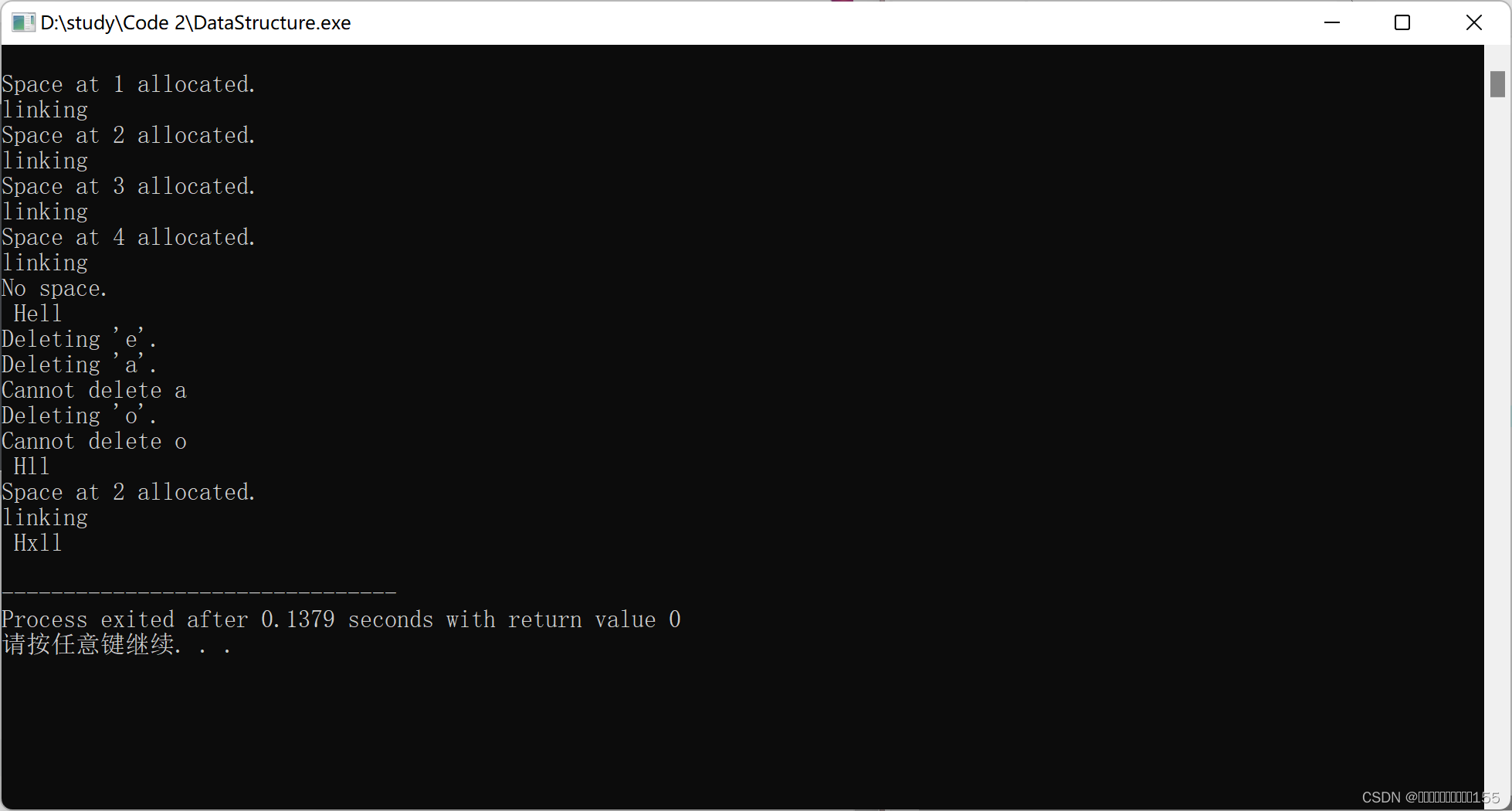静态链表概述
定义:用数组来表示链表,用数组元素的下标来模拟链表的指针.由于是利用数组来定义的链表,属于静态储存分配, 因而叫做静态链表.
结点的定义:静态链表的节点也有由两个域组成: 数据域和指针域
优点:融合顺序表和链表各自的优点,既能快速访问元素,又能快速增加或删除数据元素。
注意:使用静态链表存储数据,需要预先申请足够大的一整块内存空间。静态链表存储数据元素的个数从其创建的那一刻就已经确定,后期无法更改。
代码实现
删除元素

代码
#include <stdio.h>
#include <malloc.h>
#define DEFAULT_SIZE 5
typedef struct StaticLinkedNode {
char data;
int next;//next 是一个整数, 表示相对地址. 在操作系统中, 应该是绝对地址
} *NodePtr;
typedef struct StaticLinkedList {
NodePtr nodes;// nodes 存储节点
int* used;// used 存储空间使用情况
} *ListPtr;
//初始化链表
ListPtr initLinkedList() {
// 指向整个链表空间的指针
ListPtr tempPtr = (ListPtr)malloc(sizeof(struct StaticLinkedList));
// 分配总空间
tempPtr->nodes = (NodePtr)malloc(sizeof(struct StaticLinkedNode) * DEFAULT_SIZE);
tempPtr->used = (int*)malloc(sizeof(int) * DEFAULT_SIZE);
// The first node is the header.
tempPtr->nodes[0].data = '\0';// nodes[0]永远存储头节点
tempPtr->nodes[0].next = -1;//用 -1 表示 NULL.
// Only the first node is used.
tempPtr->used[0] = 1;// 0表示空闲, 1表示被占用
for (int i = 1; i < DEFAULT_SIZE; i ++) {
tempPtr->used[i] = 0;
}
return tempPtr;//返回头指针
}
//打印链表
void printList(ListPtr paraListPtr) {
int p = 0;
while (p != -1) {
printf("%c", paraListPtr->nodes[p].data);
p = paraListPtr->nodes[p].next;
}
printf("\r\n");
}
//在给定位置插入一元素
//paraListPtr链表中位置,paraChar给定字符,paraPosition给定位置
void insertElement(ListPtr paraListPtr, char paraChar, int paraPosition) {
int p, q, i;
//查找到该位置
p = 0;
for (i = 0; i < paraPosition; i ++) {
p = paraListPtr->nodes[p].next;
if (p == -1) {
printf("The position %d is beyond the scope of the list.\r\n", paraPosition);
return;
}
}
// 构造一个新节点
for (i = 1; i < DEFAULT_SIZE; i ++) {
if (paraListPtr->used[i] == 0) {
// This is identical to malloc.
printf("Space at %d allocated.\r\n", i);
paraListPtr->used[i] = 1;
q = i;
break;
}
}
if (i == DEFAULT_SIZE){
printf("No space.\r\n");
return;
}
paraListPtr->nodes[q].data = paraChar;
// 插入
printf("linking\r\n");
paraListPtr->nodes[q].next = paraListPtr->nodes[p].next;
paraListPtr->nodes[p].next = q;
}
//从链表中删除元素
void deleteElement(ListPtr paraListPtr, char paraChar) {
int p, q;
p = 0;
while ((paraListPtr->nodes[p].next != -1) && (paraListPtr->nodes[paraListPtr->nodes[p].next].data != paraChar)){
p = paraListPtr->nodes[p].next;
}
if (paraListPtr->nodes[p].next == -1) {
printf("Cannot delete %c\r\n", paraChar);
return;
}
q = paraListPtr->nodes[p].next;
paraListPtr->nodes[p].next = paraListPtr->nodes[paraListPtr->nodes[p].next].next;
paraListPtr->used[q] = 0;//该语句与free(q)相同
}
void appendInsertDeleteTest() {
// 初始化一个空链表
ListPtr tempList = initLinkedList();
printList(tempList);
// 添加字符
insertElement(tempList, 'H', 0);
insertElement(tempList, 'e', 1);
insertElement(tempList, 'l', 2);
insertElement(tempList, 'l', 3);
insertElement(tempList, 'o', 4);
printList(tempList);
// 删除字符
printf("Deleting 'e'.\r\n");
deleteElement(tempList, 'e');
printf("Deleting 'a'.\r\n");
deleteElement(tempList, 'a');
printf("Deleting 'o'.\r\n");
deleteElement(tempList, 'o');
printList(tempList);
insertElement(tempList, 'x', 1);
printList(tempList);
}
//接口
void main() {
appendInsertDeleteTest();
}
结果























 1万+
1万+











 被折叠的 条评论
为什么被折叠?
被折叠的 条评论
为什么被折叠?








